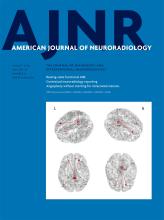Index by author
Broder, J.S.
- You have accessThink A-Head Campaign of Image Gently: Shared Decision-Making in Pediatric Head TraumaN. Kadom, B.L. Vey, D.P. Frush, J.S. Broder, K.E. Applegate and Members of the Image Gently Think A-Head Campaign CommitteeAmerican Journal of Neuroradiology August 2018, 39 (8) 1386-1389; DOI: https://doi.org/10.3174/ajnr.A5718
Burke, M.X.
- EDITOR'S CHOICEAdult BrainOpen AccessBrain Perfusion Measurements Using Multidelay Arterial Spin-Labeling Are Systematically Biased by the Number of DelaysM. van der Thiel, C. Rodriguez, P. Giannakopoulos, M.X. Burke, R. Marc Lebel, N. Gninenko, D. Van De Ville and S. HallerAmerican Journal of Neuroradiology August 2018, 39 (8) 1432-1438; DOI: https://doi.org/10.3174/ajnr.A5717
The authors assessed delay and transit time-uncorrected and transit time-corrected CBF maps in 87 healthy controls. Data analysis included voxelwise permutation-based between-sequence comparisons of 3-delay versus 7-delay, within-sequence comparison of transit time-uncorrected versus transit time-corrected maps, and average CBF calculations in regions that have been shown to differ. The 7-delay sequence estimated a higher CBF value than the 3-delay for the transit time-uncorrected and transit time-corrected maps in regions corresponding to the watershed areas. In the peripheral regions of the brain, the estimated delay was found to be longer for the 3-delay sequence while the inverse was found in the center of the brain. This study supports the necessity of standardizing acquisition parameters in multidelay arterial spin-labeling and identifying basic parameters as a confounding factor in CBF quantification studies.
Byrne, D.
- LETTERYou have accessMedullary Edema and Enhancement with a Straight Upper Border in Cases of Dural Arteriovenous FistulasD. Byrne, J.P. Walsh, T. Lynch and E.C. KavanaghAmerican Journal of Neuroradiology August 2018, 39 (8) E90-E91; DOI: https://doi.org/10.3174/ajnr.A5681
Campbell, Z.M.
- Adult BrainYou have accessDetection and Characteristics of Temporal Encephaloceles in Patients with Refractory EpilepsyZ.M. Campbell, J.M. Hyer, S. Lauzon, L. Bonilha, M.V. Spampinato and M. YazdaniAmerican Journal of Neuroradiology August 2018, 39 (8) 1468-1472; DOI: https://doi.org/10.3174/ajnr.A5704
Cao, D.
- Adult BrainOpen AccessMR Imaging Features of Anaplastic Pleomorphic Xanthoastrocytoma Mimicking High-Grade AstrocytomaD. She, J. Liu, Z. Xing, Y. Zhang, D. Cao and Z. ZhangAmerican Journal of Neuroradiology August 2018, 39 (8) 1446-1452; DOI: https://doi.org/10.3174/ajnr.A5701
Carass, A.
- FELLOWS' JOURNAL CLUBFunctionalYou have accessPreoperative Mapping of the Supplementary Motor Area in Patients with Brain Tumor Using Resting-State fMRI with Seed-Based AnalysisJ. Wongsripuemtet, A.E. Tyan, A. Carass, S. Agarwal, S.K. Gujar, J.J. Pillai and H.I. SairAmerican Journal of Neuroradiology August 2018, 39 (8) 1493-1498; DOI: https://doi.org/10.3174/ajnr.A5709
Sixty-six patients with brain tumors were evaluated with resting-state fMRI using seed-based analysis of hand and orofacial motor regions. Rates of supplementary motor area localization were compared with those in healthy controls and with localization results by task-based fMRI. Localization of the supplementary motor area using hand motor seed regions was more effective than seeding using orofacial motor regions for both patients with brain tumor and controls. Bilateral hand motor seeding was superior to unilateral hand motor seeding in patients with brain tumor for either side. The authors conclude that in addition to task-based fMRI, seed-based analysis of resting-state fMRI represents an equally effective method for supplementary motor area localization in patients with brain tumors, with the best results obtained with bilateral hand motor region seeding.
Carney, O.M.
- EDITOR'S CHOICEPediatricsYou have accessThe Bone Does Not Predict the Brain in Sturge-Weber SyndromeR.R. Warne, O.M. Carney, G. Wang, D. Bhattacharya, W.K. Chong, S.E. Aylett and K. MankadAmerican Journal of Neuroradiology August 2018, 39 (8) 1543-1549; DOI: https://doi.org/10.3174/ajnr.A5722
MR imaging of 139 children presenting with port-wine stain and/or Sturge-Weber syndrome between 1998 and 2017 was evaluated by 2 pediatric neuroradiologists for marrow signal abnormality and pial angioma and other Sturge-Weber syndrome features. Groups were divided into port-wine stain-only (without intracranial Sturge-Weber syndrome features) and Sturge-Weber syndrome (the presence of cerebral pial angioma). In the port-wine stain-only cohort, 78% had ipsilateral bony changes and 17% had no intraosseous changes. In the Sturge-Weber syndrome cohort, 84/99 had associated port-wine stain, 91% had bony changesipsilateral to the port-wine stain or had no bone changes in the absence of port-wine stain, and 77% had bony changes ipsilateral to a cerebral pial angioma. The authors conclude that intraosseous marrow changes are strongly associated with facial port-wine stain. No significant association was found between pial angioma and bone marrow changes.
Carolus, K.
- Adult BrainYou have accessImpact of Focal White Matter Damage on Localized Subcortical Gray Matter Atrophy in Multiple Sclerosis: A 5-Year StudyT.A. Fuchs, K. Carolus, R.H.B. Benedict, N. Bergsland, D. Ramasamy, D. Jakimovski, B. Weinstock-Guttman, A. Kuceyeski, R. Zivadinov and M.G. DwyerAmerican Journal of Neuroradiology August 2018, 39 (8) 1480-1486; DOI: https://doi.org/10.3174/ajnr.A5720
Carrino, J.A.
- SpineYou have accessDetection of the Stellate and Thoracic Sympathetic Chain Ganglia with High-Resolution 3D-CISS MR ImagingA. Chaudhry, A. Kamali, D.A. Herzka, K.C. Wang, J.A. Carrino and A.M. BlitzAmerican Journal of Neuroradiology August 2018, 39 (8) 1550-1554; DOI: https://doi.org/10.3174/ajnr.A5698
Chang, P.C.
- EDITOR'S CHOICEOpen AccessContextual Radiology Reporting: A New Approach to Neuroradiology Structured TemplatesM.D. Mamlouk, P.C. Chang and R.R. SaketAmerican Journal of Neuroradiology August 2018, 39 (8) 1406-1414; DOI: https://doi.org/10.3174/ajnr.A5697
Contextual reporting is an alternative method of structured reporting that is specifically related to the disease or examination indication. These disease-specific reports provide content focused on the clinical diagnosis or symptom, discuss appropriate differential diagnoses, and highlight pertinent positives and negatives. The authors created a library of 50 contextual structured reports for neuroradiologists and emphasize their clinical value over noncontextual structured reporting.








